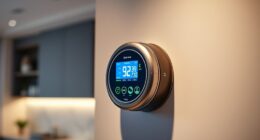Demand-response ready appliances use modern standards like OpenADR, CTA‑2045, and Matter Energy to communicate efficiently with the energy grid. OpenADR sends flexible signals for load adjustments, while CTA‑2045 provides a universal interface for appliance compatibility. The emerging Matter Energy standard guarantees seamless home connectivity across platforms. Together, these technologies help you save on bills, support grid stability, and promote sustainability. Keep exploring to discover how these standards can benefit your energy management.
Key Takeaways
- Demand-response ready appliances communicate via protocols like OpenADR for real-time load management and grid stability.
- CTA-2045 provides a universal physical interface enabling seamless interoperability among smart appliances for demand response.
- Matter Energy standard ensures universal device compatibility, secure communication, and energy-efficient features across smart home platforms.
- OpenADR enables secure, standardized messaging for load reduction, shifting, and pricing signals between utilities and appliances.
- These standards collectively enhance grid reliability, support renewable integration, and offer financial incentives for consumers.
The Role of Demand Response in Modern Energy Grids
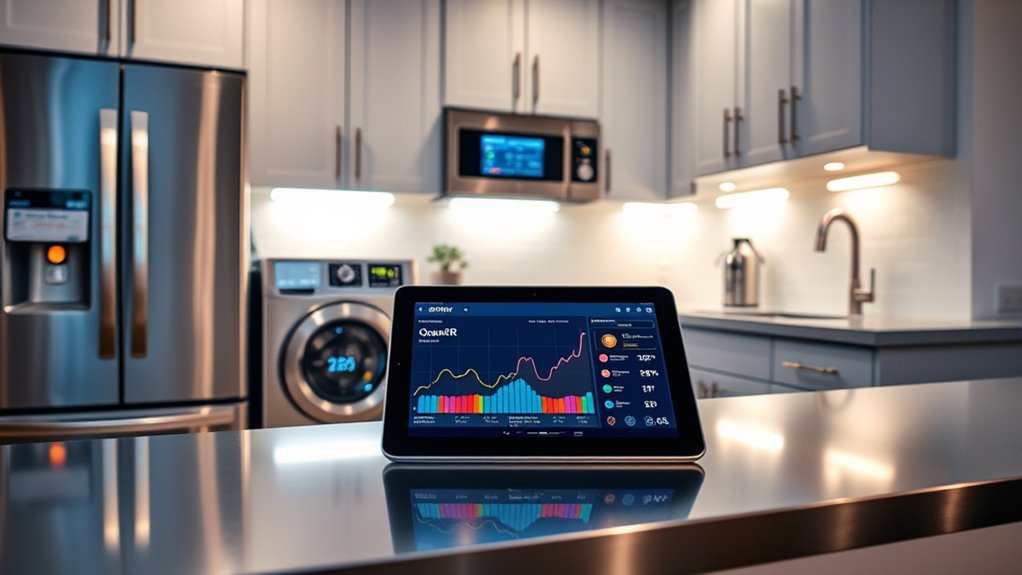
Demand response plays a vital role in modern energy grids by actively balancing supply and demand in real time. As energy consumption rises, especially with expanding data centers, EV charging, and manufacturing, DR helps manage these loads efficiently. It reduces the risk of blackouts during peak periods by encouraging users to shift or reduce demand through incentives. By integrating advanced control systems and smart appliances, DR supports grid stability and reliability, even during extreme weather or capacity shortages. This approach also decreases reliance on polluting power plants, aligning with sustainability goals. Additionally, the incorporation of smart grid technologies enhances the effectiveness of demand response strategies. With the global capacity expected to double by 2028, demand response becomes essential for handling load growth, which is driven by the adoption of smart grid technologies, ensuring a resilient, flexible, and environmentally friendly energy system.
How Smart Appliances Communicate Using OpenADR

Smart appliances communicate using the OpenADR 2.0 protocol, which provides a secure and flexible way for utilities to send signals that influence energy consumption. It uses standardized messages over internet or IP networks to convey load reduction, energy shifting, or price signals. Typically, messages pass through a Demand Response Automation Server (DRAS), which relays instructions via an energy management gateway (EMG) that translates signals into appliance commands. This setup ensures consumer control and consent before adjustments. To illustrate, here’s a simplified view:
| Appliance Type | Communication Method |
|---|---|
| HVAC Units | Via CTA-2045 modules |
| Water Heaters | Through EMG gateways |
| EV Chargers | OpenADR signals processed |
This system enables appliances to respond dynamically to grid needs while respecting user preferences. Adherence to privacy policies ensures that user data and preferences are protected during these communications. Understanding how these protocols facilitate demand response can help consumers better appreciate the role of smart appliances in energy management.
Enhancing Compatibility With Cta‑2045 Modules
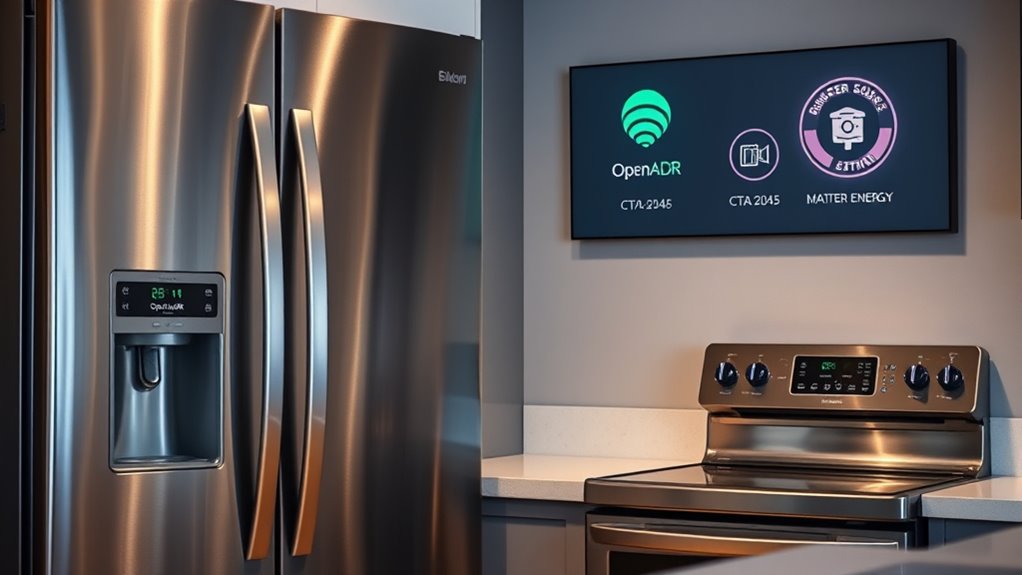
Enhancing compatibility with CTA-2045 modules is key to streamlining the integration of demand response capabilities into a wide range of appliances. The standard defines a universal physical and electrical interface, ensuring interoperability across brands and device types. It specifies two main connector forms: AC for large appliances like water heaters and DC for smaller devices such as thermostats. The communications module receives power directly from the appliance, simplifying installation. The protocol includes basic commands like “shed” and “end shed,” guaranteeing core DR functions, while supporting advanced messaging for more complex interactions. This uniform interface reduces development complexity, enabling seamless integration with diverse appliances, including water heaters, HVAC systems, and EV chargers, and fostering a more flexible, reliable smart grid ecosystem. CTA-2045 also creates a common language for appliances and utilities, facilitating easier updates and scalability as technology evolves. Additionally, standardization in private placement equity markets can promote investment in innovative energy appliances and infrastructure, which is crucial for system compatibility and widespread adoption.
The Future of Home Connectivity With Matter Energy Standard
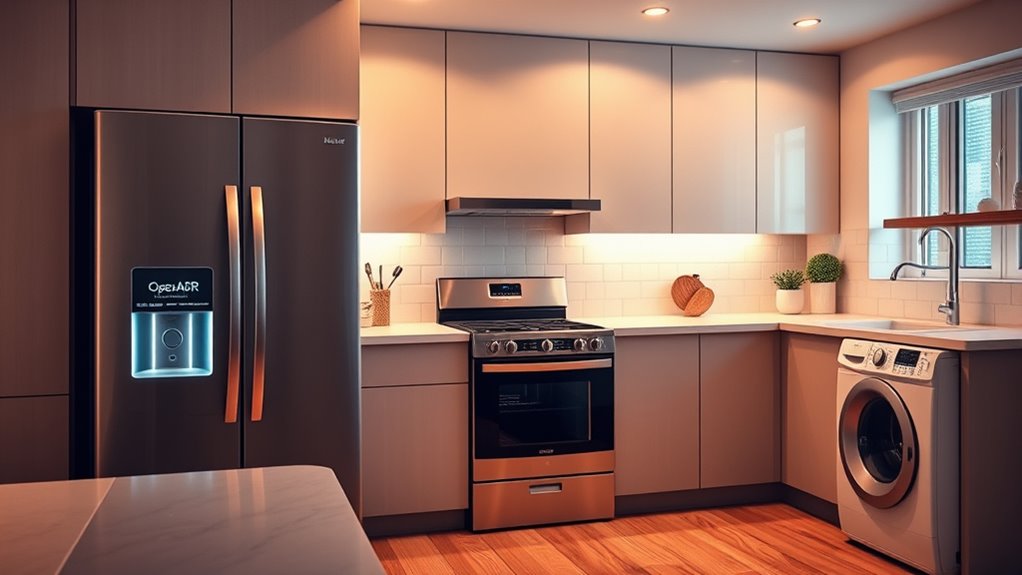
The Matter Energy Standard is shaping the future of home connectivity by creating a universal language that guarantees different smart devices work seamlessly together. This standard unifies smart home ecosystems, making device interoperability effortless, regardless of platform. It supports energy-efficient practices through intelligent energy management features, like smart thermostats and appliances. With compatibility across platforms such as Apple HomeKit, Google Home, and Amazon Alexa, Matter ensures versatile integration. Its support for Ethernet, Wi-Fi, and Thread provides reliable, robust communication, even when Wi-Fi is unavailable. Security is a priority, with protocols like AES encryption and blockchain-based commissioning safeguarding data and devices. As Matter evolves with updates like version 1.4, expect enhanced energy management and improved home network infrastructure, paving the way for smarter, more efficient homes. Open standards and interoperability are crucial for a cohesive smart home experience.]
Benefits of Demand-Response Ready Devices for Consumers and Utilities
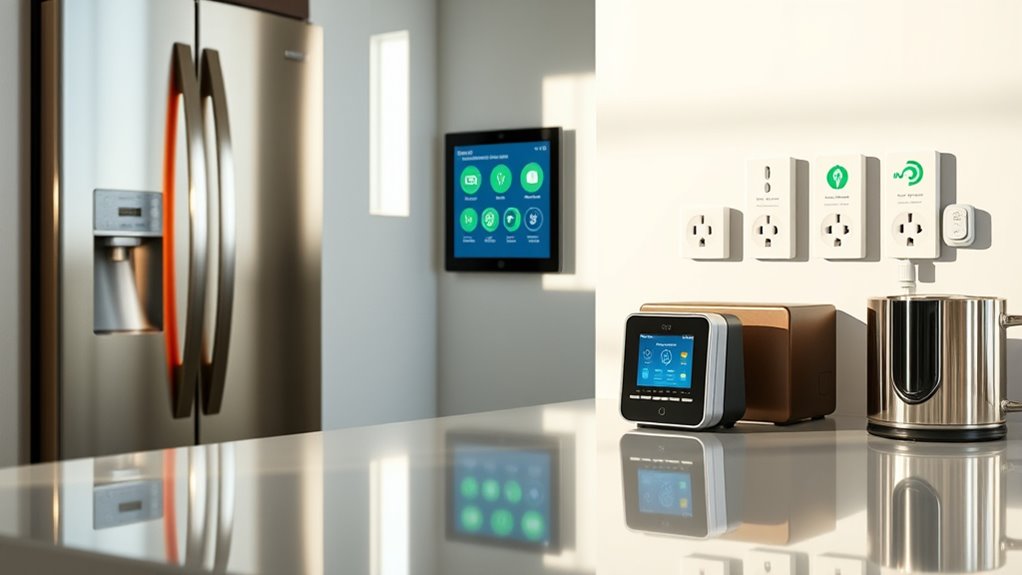
Demand-response ready devices offer significant financial advantages for consumers and operational benefits for utilities by enabling more efficient energy use during peak periods. For consumers, this means lower bills through load shifting, participation in time-of-use and real-time pricing programs, and earning rewards or bill credits for reducing energy during critical times. Imagine:
- Cutting your energy costs by shifting usage away from expensive peak hours.
- Earning incentives that boost your savings or reduce bills.
- Contributing to a more stable grid, preventing blackouts and lowering overall energy prices.
For utilities, these devices help flatten demand peaks, reducing the need for new power plants and lowering operational costs. They also enhance grid stability, improve power quality, and support integration of renewable energy sources, creating a more reliable and efficient energy system for everyone.
Frequently Asked Questions
How Do Demand-Response Appliances Impact Overall Household Energy Costs?
Demand-response appliances lower your household energy costs by enabling automated load shifting to off-peak times, reducing peak demand charges. When enrolled in demand response programs, your smart thermostats and appliances adjust settings automatically, saving energy without sacrificing comfort. Remote controls and real-time monitoring help you manage high-energy devices easily, preventing unexpected charges. Overall, these appliances help you save money by making your energy use more efficient during peak periods.
What Are the Security Features of Openadr Communication Protocols?
Did you know OpenADR uses TLS encryption in 100% of its secure communications? You’ll benefit from robust security features like X.509 certificates for authentication, ensuring both parties verify identities. Digital signatures protect message integrity, and role-based access controls restrict actions. Plus, OpenADR supports JWT tokens, making credential exchanges safer. These layered protections keep your demand-response data private, tamper-proof, and compliant with cybersecurity standards, giving you confidence in your energy management system.
Can Existing Appliances Be Retrofitted With CTA-2045 Modules?
Yes, existing appliances can often be retrofitted with CTA-2045 modules if they are physically compatible. You may need to work with OEMs to guarantee proper interface integration, especially for complex appliances. Retrofitting involves attaching a communication module that enables demand response features, allowing your appliances to respond to grid signals. Keep in mind, retrofit feasibility varies depending on appliance design, control access, and compatibility with the CTA-2045 standard.
How Does Matter Energy Ensure Interoperability Across Different Smart Home Devices?
Think of Matter Energy as a universal translator for smart devices. It guarantees interoperability by using an open-source, IP-based protocol that connects various devices over Wi-Fi, Thread, and Ethernet. This common language allows different brands and ecosystems to work together seamlessly. Multi-Admin support and backward compatibility make sure your devices communicate smoothly, regardless of manufacturer, creating a harmonious smart home where everything operates cohesively and effortlessly.
What Incentives Are Available for Consumers Adopting Dr-Ready Appliances?
You can access various incentives when adopting DR-ready appliances. Utility rebates can cover up to $8,750, with additional support for income-qualified households. Participating in demand response programs can earn you ongoing energy credits and monthly payments. Smart thermostats and appliances help you save during peak hours, and commercial programs offer reservation and performance payments. These incentives make upgrading more affordable and financially rewarding.
Conclusion
Just as Prometheus brought fire to humanity, demand-response ready appliances illuminate the path to a smarter, more responsive energy future. By embracing OpenADR, CTA-2045, and Matter Energy standards, you empower your home and support a resilient grid. Together, you can harness the power of innovation to save energy, reduce costs, and contribute to a sustainable world—proof that even small choices can spark a revolution in how we use and share energy.








